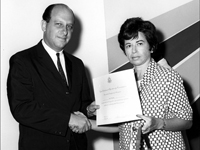1. A steadily growing number [of women] were entering the professions of medicine, law, education, religion, and the various fields of science and engineering. More and more were occupying positions of leadership in business and government formerly held only by men.
The above textbook excerpt on feminism and the post-World-Wars women's movement dates from:
a. 1966
This excerpt comes from Harcourt and Brace's Rise of the American Nation, by Lewis Paul Todd and Merle Curti. The excerpt has a tone of optimism—more and more women, the text says, were and are entering male-dominated fields. This excerpt also reveals which career fields the 1966 authors considered previously barred to women.
2. In some ways, the position of women in American society was worse in the 1960s than it had been in the 1920s. After forty years, there was a lower percentage of women enrolled in the nation's colleges and professional schools. Women were still relegated to stereotyped occupations like nursing and teaching; there were few female lawyers and even fewer women doctors.
This textbook excerpt on feminism and the women's movement dates from:
c. 1995
This excerpt comes from HarperCollins' America Past and Present, by Robert A. Divine et al. Contrast this excerpt with that in Question 1. By 1995, HarperCollins' textbook authors see the 1960s not as a period of "steady growth" in women's rights, but instead as a time in which such opportunities decreased. What changed? Certainly not events themselves. Perhaps contrast between conditions for women in 1995 and in the 1960s made the 1960s seem backward by comparison. Perhaps the different authors interpreted the same cultural trends differently. Or perhaps authors drew upon different data to create the narratives.
3. With his great popularity and shrewd handling of Congress, Reagan soon got much of his economic program passed. The final bill included $39 billion in tax cuts and a 25 percent cut in income taxes. The results of Reaganomics, however, were not quite what the President had hoped. Spending cuts, together with high interest rates, brought inflation down, but at first the cure was painful.
This textbook excerpt on Ronald Reagan's presidency dates from:
b. 1999
This excerpt comes from Glencoe McGraw-Hill's American History: The Modern Era Since 1865, by Donald A Ritchie. Contrast this excerpt with the excerpt in Question 4. In 1999, a decade after Reagan's presidency ended, this textbook's author could look back over the whole of Reagan's term and draw conclusions about the success or failure of Reagan's policies.
4. [Reagan] promised economy in government and a balanced budget, and he committed himself to "supply-side" economics, or tax reductions to businesses to encourage capital investment. But while he planned to slash federal spending, Reagan also pledged to cut income taxes and boost the defense budget—a feat John Anderson said could only be done with mirrors.
This textbook excerpt on Ronald Reagan's presidency dates from:
b. 1982
This excerpt comes from Houghton Mifflin's A People and a Nation: A History of the United States, by Mary Beth Norton et al. Contrast this excerpt with the excerpt in Question 3. In 1982, Reagan's presidency was in its early years, and textbook writers could not yet address his term in office as a neat whole. While it needed to be described—as the inevitable conclusion of the textbook's historical narrative—the recent past resisted easy integration into the text.
(Illinois Congressman John Anderson ran against Ronald Reagan in the 1980 Republican primary.)



